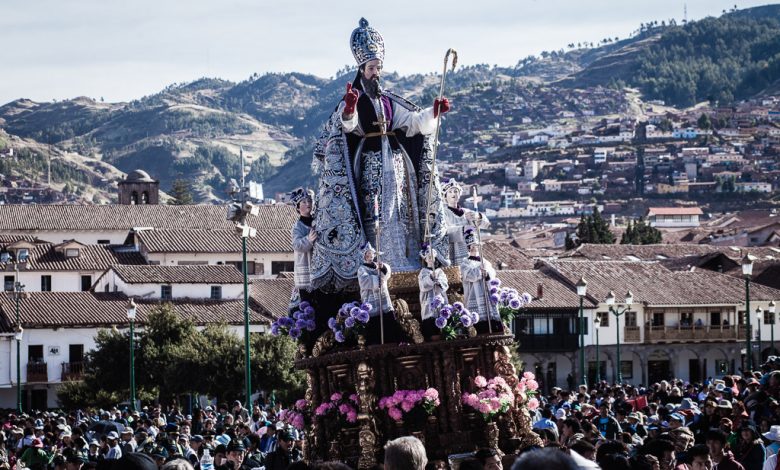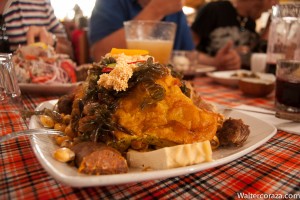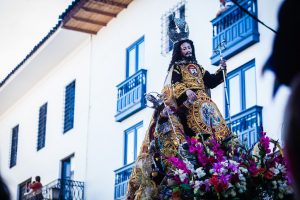Chiriuchu Animates Corpus Christi in Cuzco

Today is one of the holiest days in the calendar of Cuzco as well as a day deeply associated with history and with food. The plaza will fill, as the fifteen saints from Cuzco’s neighborhoods process around the plaza and enter into the Cathedral.
The Plaza will fill will people, both those in costume for the processions, those who have come to see, and street vendors selling ice cream, peanuts, candies, and the ever present t’oqto and canchas. The cacophony of different bands playing while accompanying their processing saints will fill the central part of the city in a play of variety and difference that is deeply Andean.
As lunch nears, people will crowd the tents set up near the Church of San Francisco to eat the dish that is most associated with this day, Cuzco’s famous chiriuchu. Uchu is an old Inca word that referred to hot peppers, as well in more general terms to prepared food. This dish, unlike most, is served cold and that seems important for the day.
One does not know why the chiriuchu is so strongly associated with today, Corpus Christi. However, this is a time of transition. Catholics recognize the saving power of Christ’s body represented in the Host, the wafer of communion. For the people of Cuzco, this is when their Saints all gather together, the differences of neighborhoods that are manifested in the different costumes of the dancers accompanying the saints, as well as the music.

Most of the year the neighborhoods of the city continue their ordinary existence with their saints among them. Each neighborhood has its own history, its own residents, its own community organizations, and its own population, just as its streets are not the same as other streets in Cuzco. However today the saints all join together and enter the Cathedral, making Cuzco symbolically come together in a whole that is also, per Church design, the Holy host.

But there is another unity, all the people sitting before plates of chiriuchu and slowly decomposing it as they enjoy one ingredient after another. The custom is to eat the different parts of this composite dish in different nibbles, rather than finishing one piece or another before going on. In this way, with each sequence of bite, people are consuming the whole and not just a part.
Just as the saints, Anne, Jerome, Christopher, and so on symbolize Cuzco’s neighborhoods and locate them in the histories of the saints and the stories them as models of life, so too the chiriuchu brings together the different regions of Cuzco. It contains cold foods that stem from the various regions nearby, whether the cheese from the high altiplano, the corn from the Sacred Valley, or the sea weed and roe from the ocean.
Each ingredient is carefully located on a plate as a means of making a mound, a kind of sacred mountain of food composed of all the parts of Cuzco. Instead of locating these parts in an ideology grounded in the Catholic Church, this plate is some how reminiscent of the only remaining, written corpus of Quechua myths, the Huarochiri Narratives. They are not from Cuzco but from a long river valley extending from the highlands to the coast. Nevertheless, as a whole the stories talk about specific localities but also locate them in terms of sacred heros that encompass the entire region from Lake Titicaca to the ocean islands near the shrine of Pachacamac, just south of Lima.

Unfortunately, any narratives that may have been embedded in chiriuchu are not available. Still people eat this dish with great relish and in this way, ingest ideas of order and balance using a mountain with its different regions and levels to provide an idea of a whole for the entire society, and not just the city of Cuzco.
The great ethnohistorian and scholar of art, Teresa Gisbert pointed out the importance of the image of the mountain. You will see it today in the dress of the female saints. It will stretch out leaving their heads at the top of a triangle or pyramid of cloth with levels and images within it, not unlike the pieces of the chiriuchu. Gisbert argued that the people of the Andes invested the Virgins with the image of a mountain and that the harmony of the notion of the Mother of God therefore blended with the notion of the Mother Earth as a mountain composed of multiple levels and pieces.
In any case, this symbol of the mountain will fill the parades today as the representative pieces of the city come together, just as it will mound up on the plates of the people of Cuzco. At the top of the plates, like the coronas of Saints, sit slices of hot peppers, usually colored both red and yellow, in the sacred colors manifested in the Huarochiri narratives and in Inca practice.
This hot pepper, with pungence and bite, is important. Hot peppers, along with salt, were things people abstained from when they fasted for holy reasons. And, hot peppers and salt are two of the Ayar brothers, (Ayar Uchu and Ayar Cachi) the founding set of brothers and sisters who are argued to have come from the mountain to become the Incas.
As a result, whether people will interpret the meal in this way or not, we can argue that when they eat this festive meal, they are ingesting key parts of the history and narratives that composed their ancestral societies at the same time they are Catholic in celebrating the feast of Corpus Christi.

The historian Carolyn Dean in her book on Cuzco’s Corpus Christ argues that it came to fill the place that Inti Raymi, the great Inca winter dry season celebration had previously occupied. As a result, there is intriguing historical continuity between it–despite its heavy Catholic vestments–and the Inca celebration of a time, a people, and a cosmos.
With this in mind, perhaps we can tackle the question of why the dish is chiri, cold. This is the time of year when the earth rests after a year of heavy production of food, and the sign of this resting is the frost that often covers the earth in the mornings. Cuzco is not only a place where people eat chiriuchu today, but they also consume papa helada with cheese. These potatoes are frozen for a night, then thawed, and served.
Right before the high day of Corpus Christi, large number of Cuzqueños also climbed a mountain to reach a glacier in the pilgrimage to Qoyllur Rit’i. Traditionally, many of the dance troupes would bring ice back from the glacier to the city.
The idea of cold is very important for this season of the year such that it makes sense that the most important food would be, of necessity, cold.
This is the time of cold nights in the highlands. But in the cold is nourished the warmer, wet season to come of rich production. Though that idea is grounded in agriculture, for modern people it still fits in their ideas of how the economy works for individuals.
While the gathering of saints carries ideas of God and heaven with its hierarchies of the saved or damned, the chiriuchu and much about the saints, such as their clothing, carry this other holy idea, of one season following another and of the earth coming to a whole in a sacred mountain.
References:
Carolyn Dean, Inka Bodies and the Body of Christ: Corpus Christi in Colonial Cuzco (Duke University Press, 1999).
Teresa Gisbert
Frank Salomon and George Urioste, The Huarochiri Manuscript (University of Texas Press, 1991).




